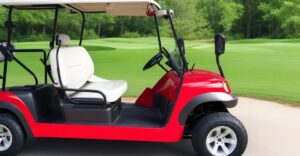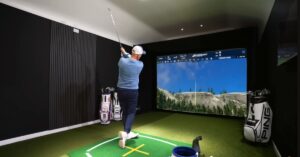How Often Should You Get New Golf Clubs? Determining The Right Time
Golf clubs are vital for a golfer’s performance, and maintaining their condition is crucial. Over time, even top-quality clubs can deteriorate, impacting your game and potentially causing harm. How often should you replace your golf clubs?
The frequency of replacing your golf clubs depends on several factors, including how often you play, the quality of your clubs, and how well you maintain them. A general rule of thumb is to replace your clubs every three to five years or so.
In this post, we’ll explore the signs of wear and tear to look out for and provide some tips to help you determine when it’s time to invest in new clubs.
how often should you get new golf clubs? Signs Or Indicators

Having the right golf equipment is vital for optimal performance on the course, and golf clubs play a significant role in your game.
Recognizing when to invest in new clubs can improve your gameplay and enjoyment of the sport.
Here are some signs to look out for.
Consistent Decrease In Performance
If you notice a decline in your overall performance, such as decreased accuracy, distance, or control, it could be a sign that your golf clubs are no longer suitable for your game. As clubs age, their components may wear down, leading to reduced effectiveness.
Frequent Repairs Or Maintenance
If you find yourself constantly repairing or maintaining your clubs, it may be an indication that they have reached the end of their lifespan.
Frequent clubhead or shaft repairs can be costly, and it might be more practical to invest in new clubs instead.
Changes In Swing Dynamics Or Physical Ability
As your swing evolves or your physical capabilities change, your clubs should adapt accordingly.
If you’ve made significant alterations to your swing or experienced physical changes, such as strength or flexibility improvements.
Outdated Technology
Golf club technology continues to advance, with new innovations enhancing performance and playability.
If your clubs are several years old and lack the latest features, you might be missing out on potential improvements in distance, forgiveness, or adjustability.
Lack Of Confidence Or Comfort
Your confidence and comfort level while using your golf clubs are essential factors in your game.
If you find yourself lacking confidence in your clubs or feeling uncomfortable during your swing, it could be a sign that it’s time for a change.
New clubs that inspire confidence and feel comfortable in your hands can positively impact your performance.
Opportunity For Customization
If your current clubs don’t offer much room for customization or don’t match your playing style, it may be worth exploring options that allow you to tailor the clubs to your preferences.
Customized clubs can provide a better fit, resulting in improved performance and consistency.
Significant Wear And Tear
Examine your clubs for signs of wear and tear, such as worn-out grips, dents or dings on the clubheads, or shafts showing signs of fatigue.
Excessive wear and tear can impact the club’s performance and durability, warranting a replacement.
Specific Clubs That Become Outdated Faster Than Others
In the world of hobbies and interests, there are certain clubs that have a tendency to wear out or become outdated faster than others.
Here, we will explore some of these specific clubs and discuss the reasons behind their accelerated decline.
Technology Enthusiast Clubs
With the rapid advancements in technology, clubs centered around specific gadgets or devices can quickly lose relevance.
Whether it’s a club dedicated to a particular gaming console or a group focused on outdated smartphones, the relentless march of progress can render these clubs obsolete as newer.
Fashion And Style Clubs
Fashion is ever-changing, and what’s considered trendy today may become passé tomorrow.
Clubs that revolve around specific fashion trends or styles can find themselves struggling to keep up with the ever-evolving tastes of their members.
This is especially true in the fast-paced world of streetwear, where new trends emerge frequently, causing once-popular clubs to fade into obscurity.
Social Media Clubs
In the era of social media dominance, clubs centered around specific platforms can quickly fall out of favor.
As new apps and platforms gain popularity, older ones can lose their appeal and user base.
This is evident in the rise and fall of various social media platforms over the years, as users migrate to newer and more engaging platforms.
Fitness And Wellness Clubs
While fitness and wellness are essential aspects of a healthy lifestyle, some clubs within this category can struggle to maintain relevance.
Fitness trends come and go, and clubs focusing on specific workout programs or training methods can find themselves left behind as new and more innovative approaches gain popularity.
Additionally, changing lifestyles and evolving preferences can impact the sustainability of these clubs over time.
Niche Hobby Clubs
Certain clubs cater to niche hobbies or interests that may have limited appeal or a small target audience.
While these clubs can be incredibly fulfilling for their members, their narrow focus can result in a lack of growth and difficulty in attracting new participants.
As broader interests gain traction, clubs dedicated to obscure or niche hobbies can struggle to keep up with the changing dynamics of the hobby landscape.
Alternatives To Getting Entirely New Golf Clubs
If you’re looking for cost-effective options or alternatives to getting entirely new golf clubs, there are several strategies you can consider.
By exploring these alternatives, you can improve your game without breaking the bank.
Used Clubs
Consider purchasing used golf clubs. Many golfers upgrade their equipment regularly, which means there’s a market for used clubs in good condition.
You can find them at local golf shops, online marketplaces, or even through classified ads. Just make sure to inspect the clubs before purchasing to ensure they are in decent shape.
Club Rentals
If you don’t play golf frequently or are unsure about committing to new clubs, renting can be a viable option. Golf courses often offer rental sets that allow you to try different clubs during your rounds.
This way, you can test different brands, models, and configurations before making a long-term investment.
Club Fittings
Instead of purchasing an entirely new set of clubs, consider getting a professional club fitting.
A club fitting session involves analyzing your swing characteristics and physical attributes to determine the ideal club specifications for your game.
The fitter may suggest adjustments to your current clubs, such as shaft length, flex, or grip size, which can enhance your performance without the need for new equipment.
Component Clubs
Another cost-effective option is to build your own clubs using component parts.
Component clubs are clubs made from individual components such as heads, shafts, and grips that you can assemble yourself or with the help of a club builder.
This approach allows you to customize your clubs according to your preferences and can often result in significant savings compared to buying pre-assembled sets.
Club Swaps Or Trade-Ins
If you have golfing friends or acquaintances who are looking to upgrade their clubs, you can explore the possibility of swapping or trading your existing clubs with them.
This way, both parties can benefit by getting new clubs without spending additional money.
Additionally, some golf retailers or online platforms offer trade-in programs where you can exchange your old clubs for credit towards new ones.
Maintenance Practices That Can Extend The Lifespan Of Golf Clubs
Golf clubs are valuable investments for avid golfers, and proper maintenance can significantly extend their lifespan.
By following a few essential practices, you can keep your clubs in top shape and ensure they perform optimally for years to come.
Clean Your Clubs After Each Round
After every round of golf, take a few minutes to clean your clubs thoroughly. Use a damp cloth or towel to wipe away dirt, grass, and debris from the clubheads, shafts, and grips. This helps prevent buildup and corrosion, which can affect performance.
Inspect And Repair Any Damage
Regularly inspect your clubs for signs of wear or damage. Look for cracks, dents, or loose components such as ferrules or hosels. If you spot any issues, consider taking your clubs to a professional club repair shop for proper maintenance and repairs.
Protect Clubheads With Headcovers
Invest in headcovers for your clubs, particularly for the driver, fairway woods, and putter. Headcovers shield the club heads from scratches, dings, and other damage, especially during transportation or storage. Keeping the clubheads protected ensures their longevity and maintains their appearance.
Avoid Hitting The Ground With The Clubhead
Striking the ground with your clubhead during swings can cause damage to the clubface, especially with irons and wedges.
Practice a smooth swing motion and aim to strike the ball cleanly without taking divots or hitting the ground excessively. This reduces the risk of denting or bending the clubface.
Store Clubs Properly
When not in use, store your golf clubs in a dry and climate-controlled environment. Avoid extreme temperatures, excessive humidity, or direct sunlight, as they can affect the materials and performance of the clubs.
Use a golf bag with individual club compartments to prevent them from banging against each other.
Replace Worn-Out Grips
Grips are a crucial part of club maintenance as they directly affect your grip and control over the club. Over time, grips wear out, lose their tackiness, and become slippery.
Replace worn-out grips with new ones to ensure a secure and comfortable hold on the club, leading to better shots.
Avoid Using Clubs As A Cane Or Lever
It may be tempting to use your clubs for purposes other than golf, but doing so can put unnecessary stress on the shafts and potentially damage them. Avoid leaning on your clubs, using them as a cane, or using excessive force when retrieving balls from hazards.
Frequently Asked Questions
How Do I Know If My Golf Clubs Need To Be Replaced?
Look for signs of wear and tear, such as worn-out grips, dents or cracks on the clubheads, or shafts that feel loose. Also, if your clubs are not suited to your swing style or physical changes, it may be time for an upgrade.
Should I Upgrade All My Clubs At Once Or One At A Time?
It depends on your budget and personal preference. Upgrading all your clubs at once can provide a consistent feel and performance, while upgrading one club at a time allows you to adjust gradually and adapt to each new club.
How Often Should I Replace My Golf Club Grips?
Golf club grips should be replaced every 1-2 years or whenever they start to show signs of wear. Worn-out grips can affect your grip on the club and lead to inconsistent swings.
What Other Factors Should I Consider When Deciding To Get New Golf Clubs?
Consider factors such as your skill level, frequency of play, budget, and advancements in club technology. Additionally, getting custom-fitted clubs can greatly improve your game by ensuring the right specifications for your swing.
Conclusion
Regularly updating your golf clubs is crucial for maintaining your performance and enjoying the game to the fullest.
Aim to replace your golf clubs every 3-5 years to take advantage of technological advancements and ensure optimal playability. Invest in new clubs to enhance your skills and stay ahead on the green.






